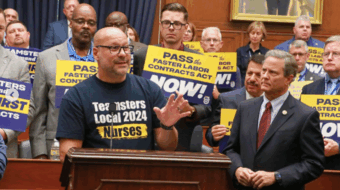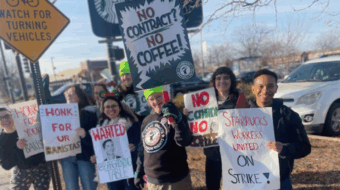The Federal Reserve has for so long been thought of as the guarantor of what’s good for big business that news out of New York yesterday came as a big surprise to many in labor and progressive circles.
For the first time ever a labor leader was appointed to a leadership role at the Fed. Dennis Hughes, president of the New York State AFL-CIO, was named chairman of the powerful Federal Reserve Bank of New York.
The New York bank is the operating arm of the Federal Reserve system in New York, northern New Jersey, Fairfield County in Connecticut, Puerto Rico and the Virgin Islands. It is the largest of the 12 Federal Reserve district banks in terms of assets and volume of activity.
The central bank has a seven-member Board of Governors in Washington, which appointed Hughes to the New York leadership post. District bank chairs are designated annually.
Hughes, a 40-year member of the Electrical Workers union (IBEW), has led the New York AFL-CIO since 1999.
Hughes, who has been a member of the district Federal Reserve Board, described that position as “a great experience.” He said it has allowed him to see firsthand how the nation’s economy really works. He told the press yesterday, “My job is to do whatever I can to make sure working families are considered when decisions are made.”
The AFL-CIO has frequently been critical of the Federal Reserve’s failure to consider working class needs in its drive for a “stable” money market. In January 2008, the labor federation severely criticized the Fed’s concentration on policies that “manipulate interest rates at the expense of following its original mandate to work to achieve a full employment economy.”
When the Federal Reserve was first created by the government in the 1913, it was charged, among other things, with the responsibility of helping create the financial conditions necessary to building a full employment economy. Unions have long said that the Fed has instead often settled for high levels of unemployment when those contribute to greater profits for big business.
Back in the 1980s, for example, Federal Reserve head Paul Volcker’s policy was to restrain the then-recovering economy from reaching full employment. His decision was that 7 percent unemployment was just about right. Seven percent will keep wages down and business booming, Volcker decided. Whether a despairing laid off worker jumped off a bridge or could not buy his kids new clothes did not factor into the Fed’s policy. After layoffs at a local steel mill a Pittsburgh banker told a reporter, “This is hardball. The steelworkers have given up a lot, but they haven’t given up enough.”
The naming of Hughes to chair the New York Fed has symbolic importance at least, observers say, with a labor leader succeeding a former Goldman Sachs executive in the post.
Stephen Friedman, who was also a former adviser to President Bush, stepped down from the chairmanship in May because of the impropriety surrounding his purchase of Goldman stock while serving on the New York Fed’s board.
The chairmanship of the powerful New York Fed has almost always gone to either a Wall Street executive or a pro-business academician. The rise of a labor leader to the position is seen as a sign of public pressure on the Fed to cut some of its ties to Wall Street.
Widely asked questions in and around the labor movement today include, “Does this show labor is gaining more power?” and “Are labor leaders being co-opted by the federal government and corporate America?”
Technically, a labor leader now runs a board whose members include General Electric CEO Jeffrey Immelt and JP Morgan Chase chief James Dimon.
Earlier this year the United Auto Workers took a seat on the General Motors board and the union got an “ownership” stake in the post-bankruptcy “re-organized” auto giant.
It is impossible to analyze these developments out of the context of a much bigger picture.
The labor movement, in its struggle to reverse the ultra-right stranglehold on the economy, has grown in power and influence. It has successfully entered the electoral arena and changed the makeup of the government. It has waged struggles for labor law reform and health care reform that could be on the verge of success. Against the backdrop of mass anger over the corporate greed that created the economic disaster, the appointment of someone like Hughes should not be seen as a surprise.
Representation of labor on the GM board, however, came about differently. There the union was forced to help bail out a poorly run enterprise, tasking financial responsibility from incompetent capitalists who couldn’t do it properly themselves.
None of these developments signal a move by labor away from militant collective bargaining struggles, fights on the electoral front, and struggles for passage of legislation, including a law that will make it easier to organize millions of new workers. They signal, instead, a labor movement that is growing stronger because of those struggles.
jwojcik @ pww.org










